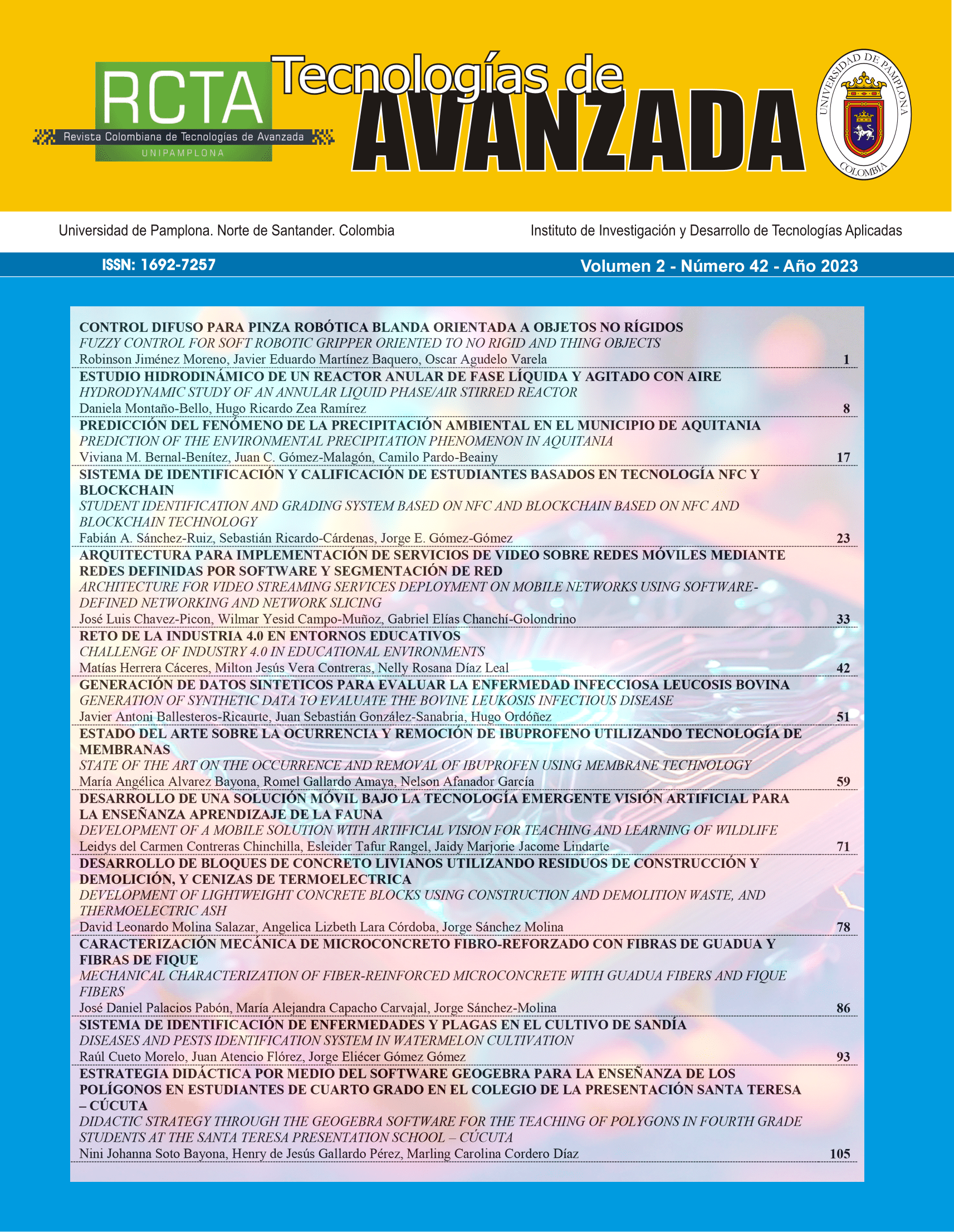Development of a mobile solution with artificial vision for teaching and learning of wildlife
DOI:
https://doi.org/10.24054/rcta.v2i42.2671Keywords:
Artificial vision, fauna, ecological tourism, teaching and learningAbstract
The objective of this article is to publicize the importance of the development of a mobile application using the emerging artificial vision technology, which allowed the identification of different animal species, and the subsequent presentation of information about the species, such as taxonomy, food, habitat, among other. This intelligent educational system promotes interactive and didactic learning, while encouraging ecological tourism. For the development of this project, an information collection instrument was applied, which allowed a diagnosis to be made on the knowledge of the population sample about the fauna of the region; subsequently, the species to be recognized by the prototype were selected and finally, the mobile application was developed using the aforementioned technology.
Downloads
References
Anacona, M. T. y Gonzalez, A. N. (2015), «La Enseñanza de la Fauna en Educacion Inicial, una propuesta alternativa,» Biografía, vol. Extraordinario, pp. 1447-1459, 2015.
Fisher, R. B., Breckon, T. P., Dawson-howe, K., Fitzgibbon, A., Robertson, C., Trucco, E., & Williams, C. K. (2014). Dictionary of Computer Vision and Image Processing. Chichester: John Wiley & Sons Ltda.
Flórez, R.C. (2012). Investigación en educación ambiental. Revista mexicana de Investigación XVII, 55:1019-1033.
Humbold, I. (2017). «Instituto De Investigación De Recursos Biológicos Alexander Von Humboldt Colombia.»
López, A. M., Imiya, A., Pajdla, T., & Álvarez, J. M. (2017). Computer Vision in Vehicles. En Computer Vision in Vehicles: Land, Sea, and Air Chichester: John Wiley & Sons Ltda:1-23
Rodríguez-Mahecha, J, Rueda-Almonacid, J. J. Rodríguez-Mahecha, J. Rueda-Almonacid y T. G. H. (2008). Guía ilustrada de la fauna del Santuario de Vida Silvestre Los Besotes, Valledupar, Cesar, Colombia. Serie de guías tropicales de campo No 7 Conservación Internacional, Bogotá, Colombia:: Editorial Panamericana.
Salinas, J., De Benito, B., & Lizana, A. (2014). Grupo de Tecnología Educativa de la Universitat de les Illes Balears.
Vélez, R.O., Pineda, L.A. (2016). «De la educación ambiental hacia la configuración de redes de sostenibilidad en Colombia .» Perfiles Educativos XXXVIII, 151: 175-187.
Álvarez, Y. J., & Rodríguez, J. L. (2016). Repositorio Institucional de la Universidad del Norte. http://hdl.handle.net/10584/5874 (Consultado: 4 de junio de 2020)
Bertolin, A. Q. (2015). UPCommons. http://hdl.handle.net/2099.1/25378 (Consultado: 4 de agosto de 2020)
Briceño, L. O., Duarte, J. E., & Fernández, F. H. (2019). Diseño didáctico para el desarrollo de destrezas básicas de Programación por medio del programa scratch a Estudiantes del grado quinto del colegio seminario Diocesano de Duitama. Revista Colombiana De Tecnologías De Avanzada (Rcta),2(34). https://doi.org/10.24054/16927257.v34.n34.2019.4006. (Consultado 04 de mayo de 2020).
Calva, D. V. (2016). Los afiches como recurso metodológico para mejorar el aprendizaje sobre la diversidad de la fauna en las islas galápago. Universidad Nacional de Loja. http://dspace.unl.edu.ec/jspui/handle/123456789/15837 . (Consultado: 20 de agosto de 2020)
Durán, C. C., Rosado., A. A., (2020). Aprendizaje activo e innovación en estudiantes de ingeniería. Revista Colombiana De Tecnologias De Avanzada (Rcta), 1(35). https://doi.org/10.24054/16927257.v35.n35.2020.3927 (Consultado 15 agosto de 2020)
Jácome, M., Torres, C., & Araujo, C. (2017). Enseñanza Del Procesamiento Digital De Imágenes a Través De Objetos Virtuales De Aprendizaje En Entornos E-Learning. Revista Colombiana De Tecnologias De Avanzada (Rcta), 2(28). https://doi.org/10.24054/16927257.v28.n28.2016.2466 (Consultado 15 junio de 2020)
Hernández, G. P. (2016). «ANEA» http://www.anea.org.mx/CongresoEAS/Docs/306P-INST-PezaHernándezV2(corr).pdf (Consultado 21 de agosto de 2020)
Published
How to Cite
Issue
Section
License
Copyright (c) 2023 Leidys del Carmen Contreras Chinchilla, Esleider Tafur Rangel, Jaidy Marjorie Jacome Lindarte

This work is licensed under a Creative Commons Attribution-NonCommercial 4.0 International License.















